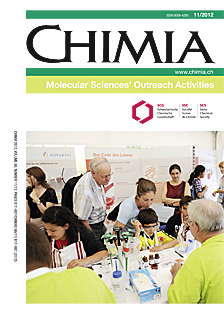The Chemist, that Madman! How Children Perceive Science
DOI:
https://doi.org/10.2533/chimia.2012.820Keywords:
Children and chemistry, Public perception of science, Science and societyAbstract
He is grown-up, not young, often bald, strictly male, often a chemist, wearing odd clothes and working on mysterious things, conducting projects which sometimes help save the world, sometimes harm our natural environment. He lives and works – often into the small hours – in a grey laboratory, alone, no colleagues, utterly isolated from the outside world. His 'space' looks like a laboratory equipped with test tubes, with reactive substances but also magic potions; mostly a windowless space, and any windows there are have iron bars. This is how, broadly speaking, and stereotypically, children see scientists. Chemistry and biology are the two most popular branches. Only rarely do we associate these images – which appear to be a simple figment of a child's imagination – to the problem of staff shortages in the 'MINT' sectors in Switzerland and to the shortfall in the number of women scientists. Nonetheless, some of the ideas presented in this article suggest that a child's outlook on science, fairly deep-rooted from as early as 9 or 10 years of age (and surprisingly unchanged by the time these kids reach secondary school) may have an impact on their future career choices. L'ideatorio, at Università della Svizzera italiana, is committed to counteracting this distorted view, in particular by creating particular spaces where children can meet science – not a 'crazy', but a normal and also female, science. In these spaces, chemistry is not synonymous with bad smells and pollution, but with benefits and discovery.He is grown-up, not young, often bald, strictly male, often a chemist, wearing odd clothes and working on mysterious things, conducting projects which sometimes help save the world, sometimes harm our natural environment. He lives and works – often into the small hours – in a grey laboratory, alone, no colleagues, utterly isolated from the outside world. His 'space' looks like a laboratory equipped with test tubes, with reactive substances but also magic potions; mostly a windowless space, and any windows there are have iron bars. This is how, broadly speaking, and stereotypically, children see scientists. Chemistry and biology are the two most popular branches. Only rarely do we associate these images – which appear to be a simple figment of a child's imagination – to the problem of staff shortages in the 'MINT' sectors in Switzerland and to the shortfall in the number of women scientists. Nonetheless, some of the ideas presented in this article suggest that a child's outlook on science, fairly deep-rooted from as early as 9 or 10 years of age (and surprisingly unchanged by the time these kids reach secondary school) may have an impact on their future career choices. L'ideatorio, at Università della Svizzera italiana, is committed to counteracting this distorted view, in particular by creating particular spaces where children can meet science – not a 'crazy', but a normal and also female, science. In these spaces, chemistry is not synonymous with bad smells and pollution, but with benefits and discovery.Downloads
Published
2012-11-26
Issue
Section
Scientific Articles
License
Copyright (c) 2012 Swiss Chemical Society

This work is licensed under a Creative Commons Attribution-NonCommercial 4.0 International License.
How to Cite
[1]
Chimia 2012, 66, 820, DOI: 10.2533/chimia.2012.820.







